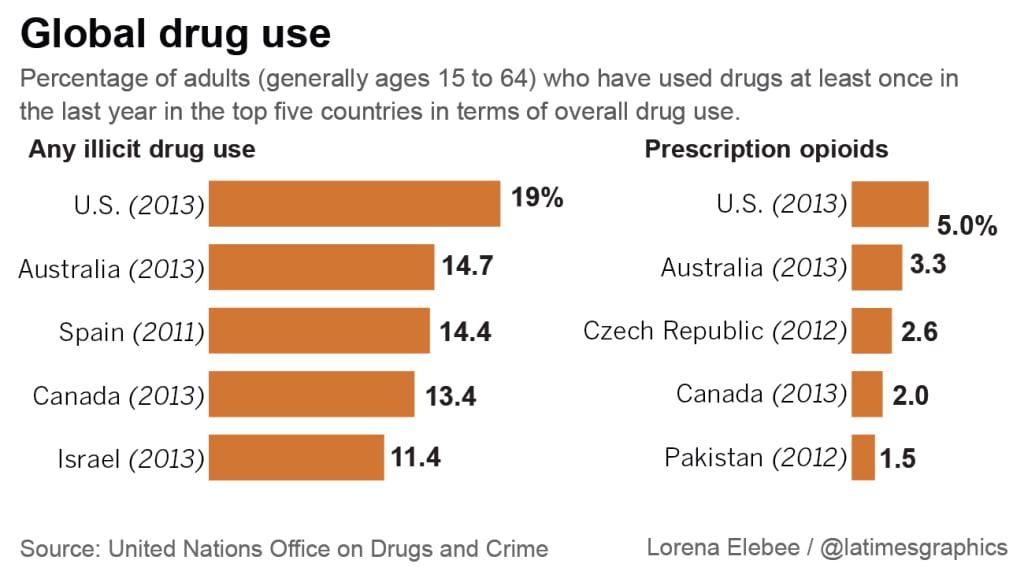Millions hooked on illicit drugs, as nations debate policy to tackle the problem
Worldwide, about 246 million people use illicit drugs

As leaders from around the world gather in New York for what many are calling the most important summit on illegal drugs in two decades, one thing is clear: The world has a serious drug problem.
Worldwide, about 246 million people use illicit drugs, and 1 in 10 of these users suffer from disorders related to drug use. Of the estimated 12 million people who inject drugs, at least 1.6 million are also living with HIV, while slightly more than half suffer from hepatitis C. Each year, 200,000 people suffer drug-related deaths, such as overdoses.
And, according to the United Nations Office on Drugs and Crime, the U.S. is leading the way, followed by Australia, Canada, Spain, Israel and Uruguay. The National Center on Addiction and Substance Abuse reports that 10% of Americans 12 and older said they had used an illicit drug in the last month.
Americans are also the greatest consumers when it comes to prescription opioids and marijuana, which remains the most widely used drug in the world, according to the U.N. drug agency.
Around the world, there were an estimated 182 million cannabis users in 2013, more than all other drug users combined.
Around 8.5% of Americans over age 12 reported using marijuana as recently as 2014, according to National Center on Addiction and Substance Abuse data. There has been a slight increase in marijuana usage, largely because of the increased acceptability of the drug, its legality in some states, and the perception that it causes a lower level of harm than other drugs, according to Linda Richter, the organization’s director of policy research and analysis.
I. Introduction
Definition of illegal drugs
Explanation of why they are illegal
II. Types of Illegal Drugs
Narcotics (e.g. heroin, cocaine)
Stimulants (e.g. methamphetamine, ecstasy)
Depressants (e.g. GHB, Rohypnol)
Hallucinogens (e.g. LSD, psilocybin mushrooms)
Synthetic drugs (e.g. synthetic cannabinoids, synthetic cathinones)
III. Effects of Illegal Drugs
Physical effects (e.g. changes in heart rate, blood pressure, respiratory rate)
Psychological effects (e.g. changes in mood, perception, cognition)
Short-term and long-term effects
IV. Consequences of Illegal Drug Use
Health risks (e.g. overdose, addiction, organ damage)
Legal consequences (e.g. arrest, imprisonment, fines)
Social consequences (e.g. strain on relationships, loss of employment)
V. Prevention and Treatment
Education and awareness campaigns
Prevention programs (e.g. DARE, Drug Abuse Resistance Education)
Treatment options (e.g. detoxification, behavioral therapy, medication-assisted treatment)
VI. Conclusion
Summary of key points
Discussion of ongoing challenges and the importance of addressing the illegal drug problem.
I. Introduction:
Illegal drugs refers to substances that are prohibited by law to produce, possess, or distribute. These can include illegal narcotics, stimulants, depressants, hallucinogens and synthetic drugs.
Illegal drugs are prohibited due to their potential harm to individuals and society, as well as their potential for abuse and addiction.
II. Types of Illegal Drugs:
Narcotics are drugs that dull the senses, such as heroin and cocaine.
Stimulants increase energy and alertness, such as methamphetamine and ecstasy.
Depressants slow down the central nervous system, such as GHB and Rohypnol.
Hallucinogens alter perception and mood, such as LSD and psilocybin mushrooms.
Synthetic drugs are chemically engineered substances that mimic the effects of other drugs, such as synthetic cannabinoids and synthetic cathinones.
III. Effects of Illegal Drugs:
Physical effects can include changes in heart rate, blood pressure, and respiratory rate.
Psychological effects can include changes in mood, perception, and cognition.
Both short-term and long-term effects can be harmful and can include addiction, overdose, organ damage, and even death.
IV. Consequences of Illegal Drug Use:
Health risks can include overdose, addiction, and organ damage.
Legal consequences can include arrest, imprisonment, and fines.
Social consequences can include strain on relationships and loss of employment.
V. Prevention and Treatment:
Education and awareness campaigns aim to inform the public about the dangers of illegal drug use and how to prevent it.
Prevention programs such as DARE (Drug Abuse Resistance Education) aim to educate young people about the risks of drug use and how to resist peer pressure.
Treatment options include detoxification, behavioral therapy, and medication-assisted treatment.
VI. Conclusion:
The illegal drug problem is a complex issue that affects individuals and society as a whole.
Despite ongoing challenges, it is important to continue to address the issue through education, prevention, and treatment programs, to help reduce the harm caused by illegal drugs.
About the Creator
Yuvaraj Murugasan
"Discover thought-provoking content on our page. From latest news and mystery,crime,thiriller,death to cutting-edge technology, we offer something for everyone. Join us for a journey of learning and inspiration. Stay tuned!"






Comments
There are no comments for this story
Be the first to respond and start the conversation.